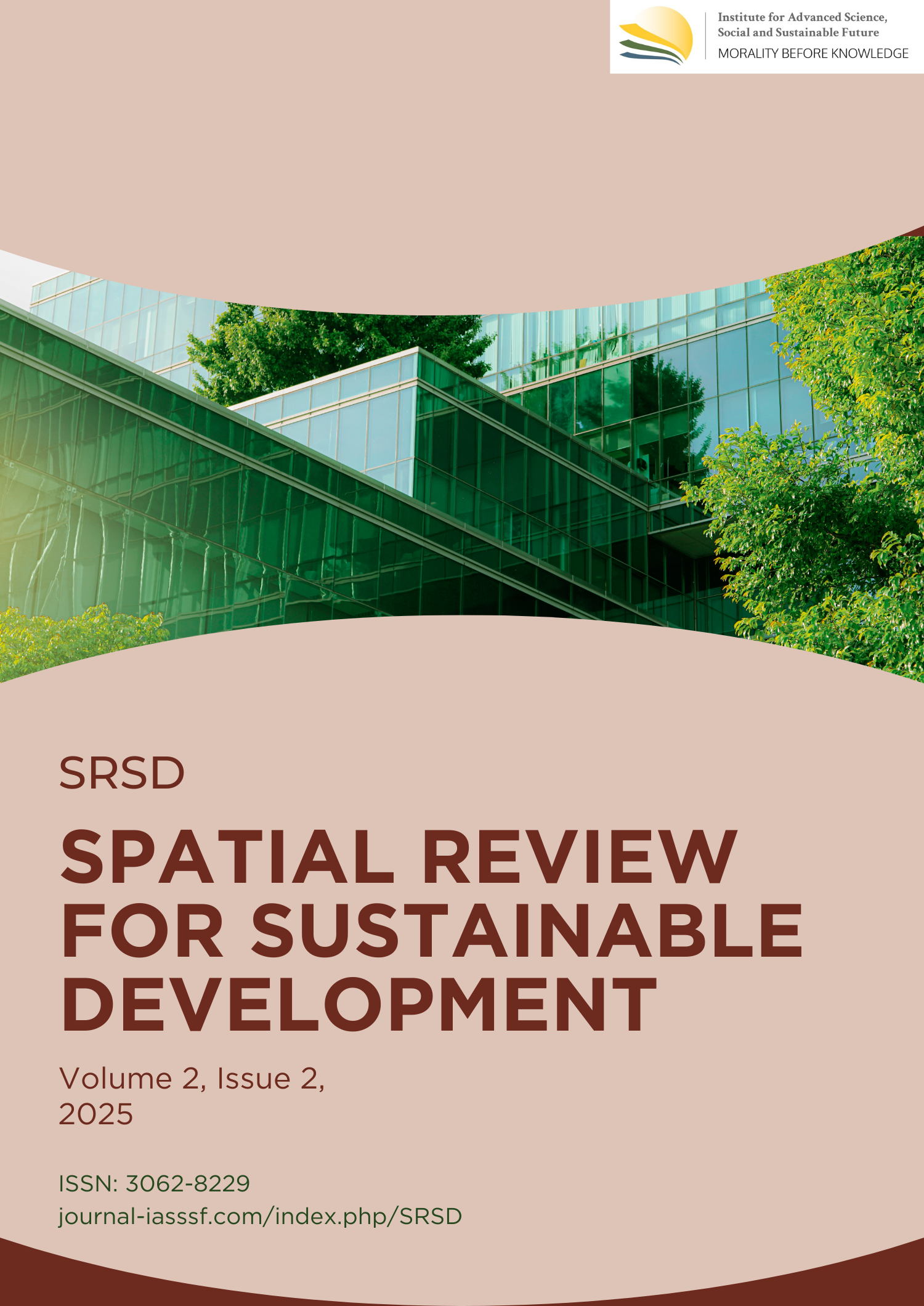Mapping household physical vulnerability to tidal floods through indicator-based scoring analysis
DOI:
https://doi.org/10.61511/srsd.v2i2.2025.1657Keywords:
physical vulnerability mapping, tidal flood, scoring analysis, household level, adaptation strategiesAbstract
Background: Tidal flooding is a significant problem in the coastal areas of Semarang City, due to climate change and environmental pollution issues. Method: The research method involved direct observation and interviews with homeowners to collect primary data, as well as scoring analysis based on four main indicators. This study used a structural indicator-based scoring analysis approach to assess the physical vulnerability of houses to tidal flooding. Findings: Tambakrejo area, which is a coastal area, also experiences periodic inundation due to sea level rise. The physical vulnerability of houses in this area is influenced by various factors, such as building materials, building age, floor height, and building height. The results show that most houses in Tambakrejo have a moderate level of vulnerability, with building materials and age as the main causes. Houses with wooden materials and more than 20 years old are more vulnerable to damage from inundation, while multi-storey houses and those with higher floors have better resilience. Conclusion: The study highlights that building materials and age are key factors affecting the physical vulnerability of houses to tidal flooding in Tambakrejo, Semarang City, and suggests consideration of structural indicators in flood risk mitigation. Novelty/ originality of this article: The novelty of this study lies in using a structural indicator-based scoring analysis to assess the physical vulnerability of houses to tidal flooding in Tambakrejo, highlighting building materials, age, and floor height as key factors.
References
Afifah, S., & Hizbaron, D. (2020). Vulnerability assessment of residential buildings to tidal flood hazards in Sriwulan Village, Sayung District, Demak Regency. E3S Web of Conferences, 200, 01008. https://doi.org/10.1051/e3sconf/202020001008
Albano, R., Limongi, C., Dal Sasso, S. F., Mancusi, L., & Adamowski, J. (2024). Flood scenario spatio-temporal mapping via hydrological and hydrodynamic modelling and a remote sensing dataset: A case study of the Basento river (Southern Italy). International Journal of Disaster Risk Reduction, 111, 104758. https://doi.org/10.1016/j.ijdrr.2024.104758
Aprijanto, Prijambodo, T., Wibawa, B., Fithor, A., Santoso, M. A., Irfani, M., … & Sukmana, C. I. (2025). Innovative strategies for tidal flood protection: A systematic literature review on spatial management in coastal city (case study: Semarang City, Central Java, Indonesia). Marine Systems & Ocean Technology, 20(1), 9. https://doi.org/10.1007/s40868-024-00158-5
Arif, D. A., Mardiatno, D., & Giyarsih, S. R. (2017). Kerentanan masyarakat perkotaan terhadap bahaya banjir di Kelurahan Legok Kecamatan Telanipura Kota Jambi. Majalah Geografi Indonesia, 31(2), 139–148. https://doi.org/10.22146/mgi.29779
Calvin, K., Dasgupta, D., Krinner, G., Mukherji, A., Thorne, P. W., Trisos, C., … & Hauser, M. (2023). Climate Change 2023: Synthesis Report. Contribution of Working Groups I, II and III to the Sixth Assessment Report of the Intergovernmental Panel on Climate Change (IPCC AR6). IPCC. https://doi.org/10.59327/IPCC/AR6-9789291691647
Cutter, S. L., Boruff, B. J., & Shirley, W. L. (2003). Social vulnerability to environmental hazards. Social Science Quarterly, 84(2), 242–261. https://doi.org/10.1111/1540-6237.8402002
Danianti, R. P., & Sariffuddin. (2015). Tingkat kerentanan masyarakat terhadap bencana banjir di Perumnas Tlogosari, Kota Semarang. Jurnal Pengembangan Kota, 3(2), 90–99. https://doi.org/10.14710/jpk.3.2.90-99
Dunning, M. C., & Durden, S. (2013). Social vulnerability analysis: A comparison of tools. IWR White Paper. U.S. Army Corps of Engineers. http://www.iwr.usace.army.mil/Portals/70/docs/iwrreports/Social_Vulnerability_Analysis_Tools.pdf
Effiong, C., Ngang, E., & Ekott, I. (2024). Land use planning and climate change adaptation in river-dependent communities in Nigeria. Environmental Development, 49, 100970. https://doi.org/10.1016/j.envdev.2024.100970
Esariti, L., Handayani, W., & Purnomo, M. S. (2024). Vulnerability assessment of tidal flood prone disaster settlement of Muarareja Tegal. IOP Conference Series: Earth and Environmental Science, 1394(1), 012036. https://doi.org/10.1088/1755-1315/1394/1/012036
Fariz, T. R., Jatmiko, R. H., & Mei, E. T. W. (2023a). Pemanfaatan foto udara UAV untuk pemetaan kerentanan fisik rumah terhadap longsor di Sub-DAS Bompon. Jurnal Ilmu Lingkungan, 21(4), 819–829. https://doi.org/10.14710/jil.21.4.819-829
Fariz, T. R., Jatmiko, R. H., Mei, E. T. W., & Lutfiananda, F. (2023b). Interpretation on aerial photography for house identification on landslide area at Bompon sub-watershed. AIP Conference Proceedings, 2683(1), 050004. https://doi.org/10.1063/5.0125382
Fariz, T. R., Nugraha, F. A., Putra, G. A. Y., Nugroho, A. A., Salima, D. R., Pradiny, L. E., & Mubarizi, E. F. (2022). Kajian kapasitas masyarakat berbasis aset penghidupan terhadap bencana kekeringan. LaGeografia, 21(1), 31–43. https://doi.org/10.35580/lageografia.v21i1.37174
Fitria, L. M., Ni’mah, N. M., & Danu, L. K. (2019). Kerentanan fisik terhadap bencana banjir di kawasan perkotaan Yogyakarta. Reka Ruang, 2(1), 1–9. https://doi.org/10.33579/rkr.v2i1.1048
Huda, M. N., Nirmala, R. J., & Yusuf, I. M. (2024). Policy incoherence and reactive approaches: Barriers to effective management of land subsidence in Semarang City, Indonesia. Jurnal Ilmu Sosial, 23(1), 1–16. https://doi.org/10.14710/jssis.2024.39228
Hung, C. H., Hung, H. C., & Hsu, M. C. (2024). Linking the interplay of resilience, vulnerability, and adaptation to long-term changes in metropolitan spaces for climate-related disaster risk management. Climate Risk Management, 44, 100618. https://doi.org/10.1016/j.crm.2024.100618
Jabbar, A., Fariz, T. R., Putri, S. D., Rahmawati, D., Prahmani, Y. S., Putri, R. A., … & Chasanah, A. N. (2023). Tidal flood susceptibility mapping and community adaptation assessment in Semarang Utara District. Journal of Environmental and Science Education, 3(1), 56–62. https://doi.org/10.15294/jese.v3i1.64910
Juniarti, T., Hendarso, Y., & Soraida, S. (2021). Peran pembimbing kemasyarakatan dalam pembimbingan dan pengawasan klien selama menjalani masa integrasi di BAPAS Kelas 1 Palembang. Jurnal Media Sosiologi, 24(1), 12–20. https://doi.org/10.47753/jms.v24i1.74
Macusi, E. D., Diampon, D. O., & Macusi, E. S. (2025). Understanding vulnerability and building resilience in small-scale fisheries: The case of Davao Gulf, Philippines. Climate Policy, 25(1), 1–14. https://doi.org/10.1080/14693062.2023.2261889
Moloney, S., & Fünfgeld, H. (2015). Emergent processes of adaptive capacity building: Local government climate change alliances and networks in Melbourne. Urban Climate, 14, 30–40. https://doi.org/10.1016/j.uclim.2015.06.009
Naja, D. A., & Mardiatno, D. (2017). Analisis kerentanan fisik permukiman di kawasan rawan bencana tsunami wilayah Parangtritis, Yogyakarta. Jurnal Bumi Indonesia, 7(1), 1–12. https://doi.org/10.31227/osf.io/228864
Pamekas, E. B. Z., & Poli, J. O. W. H. (2019). Adaptasi masyarakat bantaran sungai terhadap banjir di Kelurahan Pakowa Kota Manado. Spasial, 6(2), 482–492. https://ejournal.unsrat.ac.id/v3/index.php/spasial/article/view/25330
Peduzzi, P. (2019). The disaster risk, global change, and sustainability nexus. Sustainability, 11(4), 957. https://doi.org/10.3390/su11040957
Pradika, M. I. (2012). Kajian risiko tsunami terhadap bangunan gedung non-hunian dengan aplikasi PJ dan SIG di Kota Pacitan. Jurnal Bumi Indonesia, 1(3), 1–12.
Rahmawati, L., & Setiawan, D. (2019). Dinamika sosial ekonomi masyarakat perkotaan: Studi kasus Kelurahan Tambak Rejo, Semarang. Jurnal Ilmu Sosial dan Humaniora, 8(1), 75–90.
Saputri, A. D., & Linda, A. M. (2023). Government policies in addressing land subsidence dynamics in Tambakrejo Semarang. Riwayat: Educational Journal of History and Humanities, 6(1), 133–143. https://doi.org/10.56370/jhlg.v4i3.356
Subasinghe, C., & Kawasaki, A. (2021). Assessment of physical vulnerability of buildings and socio-economic vulnerability of residents to rainfall induced cut slope failures: A case study in central highlands, Sri Lanka. International Journal of Disaster Risk Reduction, 65, 102550. https://doi.org/10.1016/j.ijdrr.2021.102550
Suherman, H., Setianingsih, A., & Toha, R. (2023). Analysis of social vulnerability to rob floods in North Semarang District. Jurnal Pendidikan Geografi Undiksha, 11, 179–187. https://doi.org/10.23887/jjpg.v11i2.59398
Syafitri, A. W., & Rochani, A. (2022). Analisis penyebab banjir rob di kawasan pesisir (Jakarta Utara, Semarang Timur, Kabupaten Brebes, Pekalongan). Jurnal Kajian Ruang, 1(1), 16–24. https://doi.org/10.30659/jkr.v1i1.19975
Tarchiani, V., Massazza, G., Rosso, M., Tiepolo, M., Pezzoli, A., Ibrahim, M. H., … & Rapisardi, E. (2020). Community and impact based early warning system for flood risk preparedness: The experience of the Sirba River in Niger. Sustainability, 12(5), 1802. https://doi.org/10.3390/su12051802
Utomo, D. D., & Marta, F. Y. D. (2022). Dampak bencana alam terhadap perekonomian masyarakat di Kabupaten Tanah Datar. Jurnal Terapan Pemerintahan Minangkabau, 2(1), 92–97. https://doi.org/10.33701/jtpm.v2i1.2395
Ullah, W., Dong, H., Shah, A. A., Xu, C., & Alotaibi, B. A. (2025). Unveiling the multi-dimensional vulnerabilities of flood-affected communities in Khyber Pakhtunkhwa, Pakistan. Water, 17(2), 198. https://doi.org/10.3390/w17020198
UNISDR. (2015). Global assessment report on disaster risk reduction 2015. United Nations Office for Disaster Risk Reduction. https://www.preventionweb.net/gar
Young, A. F. (2014). Coastal megacities, environmental hazards and global environmental change. In M. Pelling & S. Blackburn (Eds.), Megacities and the coast (pp. 70–99). Routledge. https://doi.org/10.4324/9780203066423-14
Yu, L., Qin, H., Huang, S., Wei, W., Jiang, H., & Mu, L. (2024). Quantitative study of storm surge risk assessment in an undeveloped coastal area of China based on deep learning and GIS: A case study of Double Moon Bay. Natural Hazards and Earth System Sciences, 24(6), 2003–2024. https://doi.org/10.5194/nhess-24-2003-2024
Yuliastuti, N. (2023). Social vulnerability level appraisal at tidal flood areas: The case of a coastal settlement in Indonesia. International Review for Spatial Planning and Sustainable Development, 11(2), 99–113. https://doi.org/10.14246/irspsd.11.2_99
Downloads
Published
Issue
Section
Citation Check
License
Copyright (c) 2025 Trida Ridho Fariz, Taufik Bahrul Rizky, Vera Angelina Holeng, Meilinda Damayanti, Andhina Putri Heriyanti

This work is licensed under a Creative Commons Attribution 4.0 International License.














